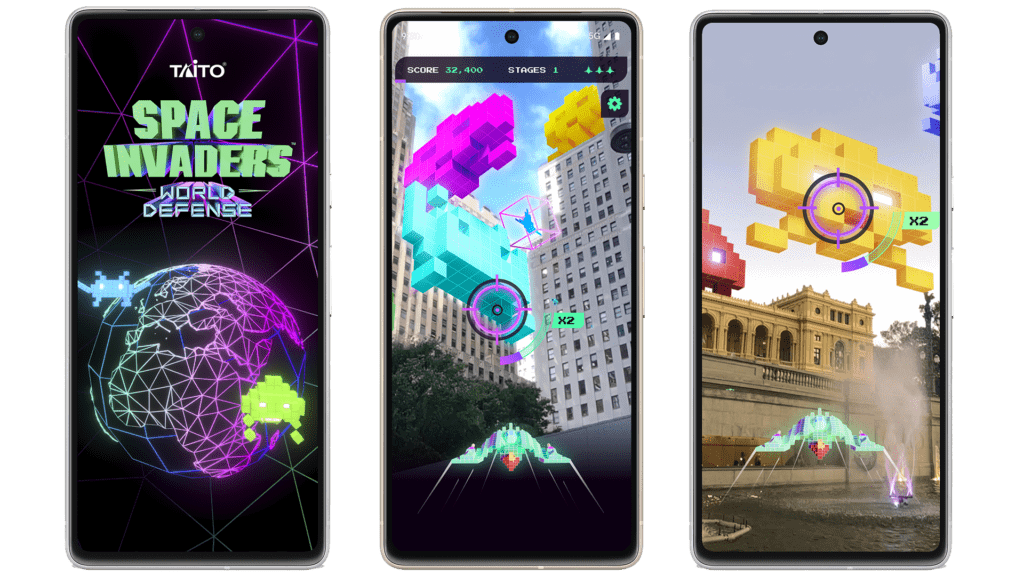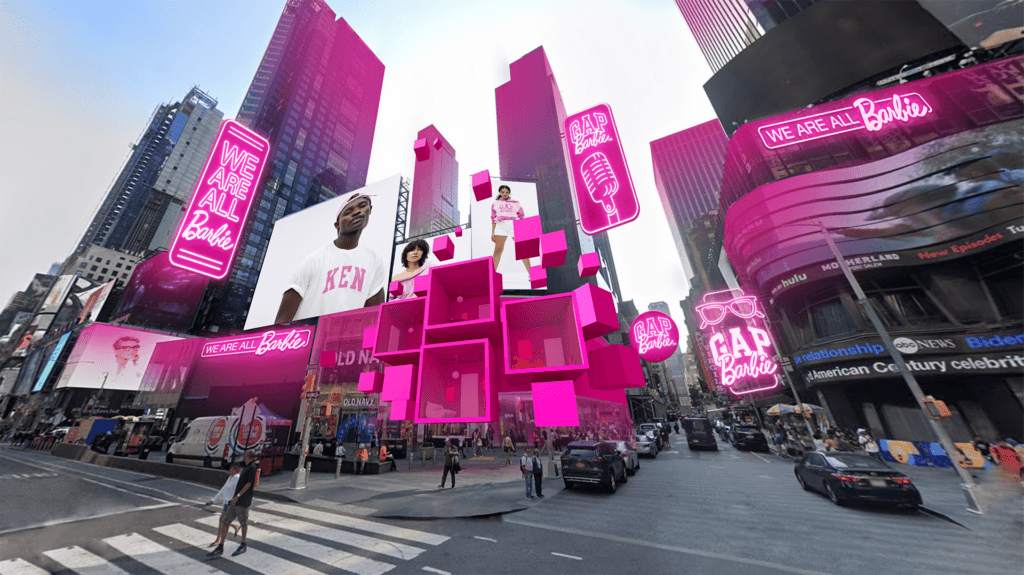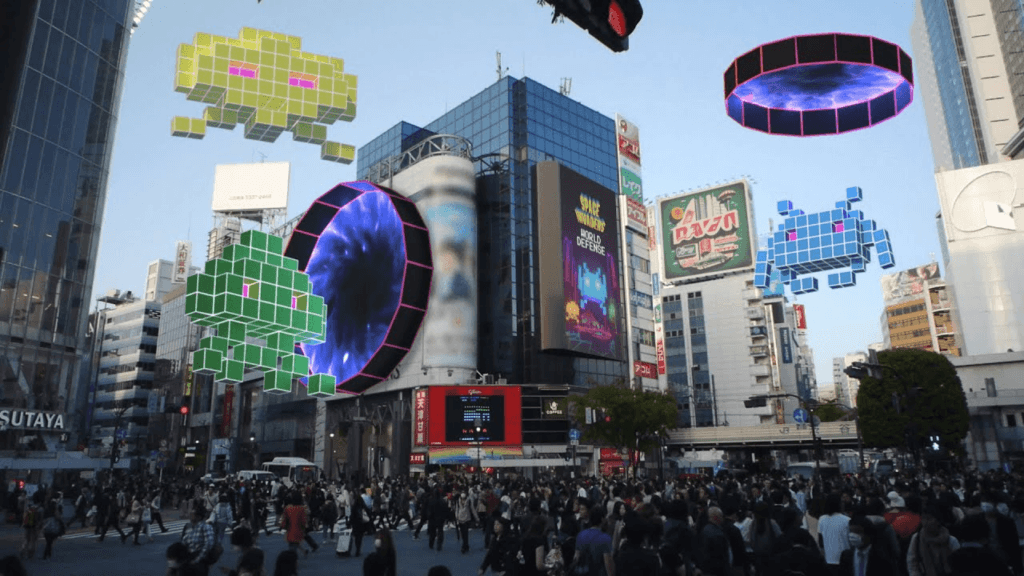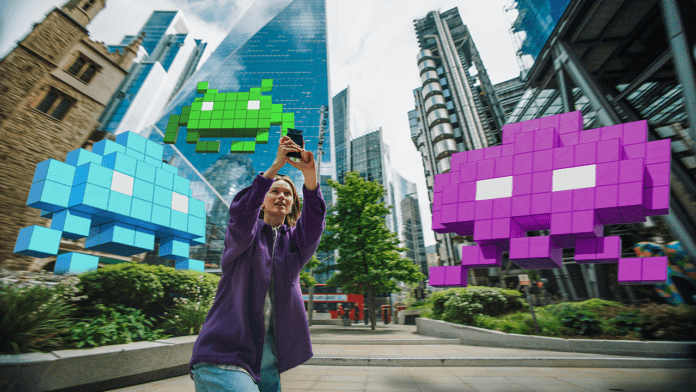The SPACE INVADERS AR launch is an immersive, geospatial, branded Location-Based Experience
by Tammie Richards
We absolutely believe this is the dawn of a new era of localized immersive experiences,” says Media Ridha, Head of Digital at UNIT9. She was referring to the new SPACE INVADERS: World Defense mobile game for Android and iOS. Thanks to a pioneering collaboration between game developer TAITO, Google, and the digital storytellers at UNIT9, players are literally going outdoors to defend their local neighborhoods from Invaders – freed from the gaming console by the ability to use Augmented Reality (AR), on their smartphones or tablets, coupled with the latest features of Google’s ARCore Geospatial technology.
From arcade to streetside is a dramatic platform shift for a classic video game, and SPACE INVADERS became one of the world’s most popular after its introduction by TAITO more than a generation ago. The team worked to achieve a recreation that would be both authentic and state-of-the-art. “UNIT9 were selected as the creative developer for the game, supporting creative and technical production of the experience alongside Google and TAITO – ensuring that the IP was safeguarded, and the experience harnessed the full power and potential of Geospatial technology,” explained Media. In the following interview, Media was our guide on how this magical collaboration came together and the project ultimately materialized.
“2023 marks the 45th anniversary of the original SPACE INVADERS hitting the market,” she says, “and TAITO and Google wanted to do something big to celebrate, and leverage Google’s latest ARCore technology – Geospatial API, Streetscape Geometry API, and Geospatial Creator to bring SPACE INVADERS into the modern day.”
Offering something for all players and tapping a deep well of fan loyalty, the 45th anniversary resurgence of the game became its own “space mission” of sorts. This timely and novel approach helped set a path for future experiential opportunities as Augmented Reality and Virtual Reality are adopted across a multitude of industries. In the realm of Location-Based Entertainment (LBE), it suggests new directions for operators to bring IP to life and increase audience engagement.

Interview with Media Ridha, UNIT9
Tell us more about how the tech is used to achieve a “next level” experience.
Google’s ARCore Geospatial API enables you to attach content remotely to any area mapped by Google Street View and create richer and more robust immersive experiences linked to real- world locations on a global scale. This is game-changing for brands, venues and IP owners looking to seamlessly blend the physical and digital worlds and create localized experiences at a global scale.
More than 100 countries have coverage in Street View, enabling SPACE INVADERS: World Defense gameplay to be adapted to cities, towns and villages. This is unlike previous AR games that rely on AR overlays but no environmental interaction. For instance, in SPACE INVADERS: World Defense, the Invaders can spawn from buildings in the environment. This is the crux of the ‘level up’ in AR technology – and the level of interaction and integration between digital and physical environments that it offers.
How are global concepts of themed entertainment and cultural placemaking impacted when the whole world itself becomes a playground?
The beauty of Geospatial API is that it can turn the whole world into a canvas for play, creating more opportunities for cultural placemaking. Experiences can become more contextual, personalized and relevant for that local audience.
The creative opportunities are uninhibited by physical or location restraints. For themed entertainment, this could mean that IP can be augmented through the context of a specific location – blending creative IP within a skyline, pulling in elements such as nearby landmarks into its narrative, customizing the storytelling experience and making it specific to a user’s immediate surroundings. Combining this approach with gaming brings a sense of playfulness.
How does this game rollout open new vistas for Location- Based Entertainment?
It’s important to understand the impact this will have on themed experiences of any kind, not just gaming.
Immersive IP activations and launches can be tailored to local areas, connecting on a deeper level with different cultures and neighborhoods. In a theme park, this technology can eliminate the need for costly physical build changes, with digital content being refreshed with ease to effectively theme different areas and offer visitors a magical and ever-changing experience.
Wayfinding can also be revolutionized with this technology. Cultural institutions can use it to elevate guided tour experiences (an exemplary collaboration between Google and the Singapore Tourism Board is revelatory). There’s also a huge opportunity for immersive retail, with stores able to expand their physical footprint into the space around them. We helped Gap and Mattel do this to launch their Barbie clothing collection, taking over Times Square with Barbie characters anchored to Gap’s flagship store and neon pink signs popping up all around the square for full immersion.

Can you elaborate on decisions supporting AR as the story- making approach?
Using AR was inherent to the whole experience – the technology was the perfect way to bring SPACE INVADERS into the real world in 2023, and it’s an incredible storytelling tool. We knew that we needed to make this experience fun – and by bringing the IP together with the latest interactive and immersive technology, we were able to create a game that we knew both older and younger players would enjoy. Making the tech invisible and intuitive was a conscious decision to bring surprise and delight to the game design while making it easy and enjoyable for players to use.
The features of Google’s ARCore that we used – such as Geospatial API and Streetscape Geometry API – and the integration of other APIs to consider the user’s weather conditions and nearby environment meant that we were able to influence the game mechanics and visuals to create an even more compelling story and draw players into the world of SPACE INVADERS.
We did, however, make the decision not to solely rely on AR to drive the narrative of the entire experience. It can be tiring for users to keep holding their hands up for a prolonged period of time in an AR experience. This knowledge influenced our gameplay development and led us to introduce a mode of play where users can hold their phones down instead of straight in front of them and battle Invaders on-screen. This new ‘Invader’s dimension’ of play allowed us to introduce new levels and provided an extension to the story.
Tying into Google’s grid was a bold step. Was it always a goal to get users to go play outside?
We worked closely with Google from the outset, and it was always a requirement that the game would utilize the Geospatial API and its key features as part of the game. We wanted to showcase the power of these tools and highlight the new location-based experiences they can unlock. Google wanted to encourage players to experience their neighborhoods with new eyes, discovering places they might not have before. So, enabling users to go outside and turn their own neighborhoods into playgrounds was very much a key aspect of the experience.
Geospatial API provided geometry data of terrain, buildings, and other structures within a 100m radius of the user’s current location so that SPACE INVADERS could emerge from all around. This allowed us to explore whole new levels for players to explore, with Invaders travelling over roofs, through narrow passages, flying around and over skyscrapers, and diving back to street level.
We have also launched an Indoor Mode for players who prefer to game at home or who are not able to play outside (there may be no or low Google Street View coverage in the area) extending the reach of the game even further.
What efforts were undertaken to ensure authenticity in delivering the game onto the new platform?
Safeguarding the SPACE INVADERS IP and maintaining authenticity were huge priorities. TAITO played a critical role in ensuring that our design, game mechanics and storytelling aligned with the original, while providing us with the flexibility and imagination to push it into the future.
The SPACE INVADERS IP is and will always be legendary within the gaming industry – it means so much to so many. We wanted to pay homage to the original title while bringing it into the modern day, elevating it with the latest immersive technology. We respectively paid close attention to elements like Invaders movement and patterns, exploring audio by upgrading the original sound effects, and keeping that arcade style playability and high score goals. But we were also able to get a bit creative and incorporate new additions, such as new weapons, power-ups and the real-time condition-adaptable levels. Successfully balancing that sense of nostalgia with cutting-edge technology to appeal to multiple generations of players was a challenge, but one which was successfully approached thanks to close work with our stakeholders from TAITO and Google.
How are you making it all happen, tech-wise, for long-term operations and QC maintenance?
Close collaboration with Google and TAITO from the beginning, throughout the launch and continuing now afterwards, has been crucial to ensure the ongoing success of the experience. We have an incredibly talented team of experts at UNIT9 with a rigorous process of long-term live ops and support plans in place. We’ve also been monitoring live feedback loops in audience responses to consider new features where relevant.
It is truly exciting to contemplate what comes next for these new technologies. Attractions industry gurus have long mulled best practices to entice and redirect visitors’ eyes (and brains) up and out of their mobile devices. But audiences are forever changed, and rather than fight smartphones as a distraction, incorporating the device into experiences offers greater potential for fandom success and engagement, with built-in added benefits such as data capture and deeper consumer impressions. Now, there’s the power to unleash immersive experiences in our own backyards. – T.R.
Attractions by UNIT9 helps brands and institutions unlock the future of experience and reach new audiences. Visit https://www.unit9.com/attractions •
With 30+ years in events, brand marketing and entertainment experiences, Tammie first trained professionally as an actor and production stage manager at LACC Theatre Academy. Six Flags Show Operations led her into permitting and technical field production for movie premieres and publicity stunts. She recently served as Themed Entertainment Association’s Director of Events, producing their Thea Awards show galas, experiential design conferences, and IAAPA-week events annually from 2014-2021.Tammie is known by peers for her smile and witty humor, while balancing life with a happy hubby and mothering 3 sons (who all lean in for her peck on the cheek).Visit www.pearsonrichards.com









